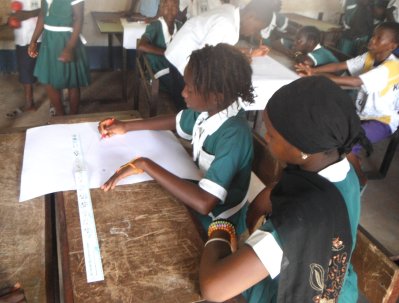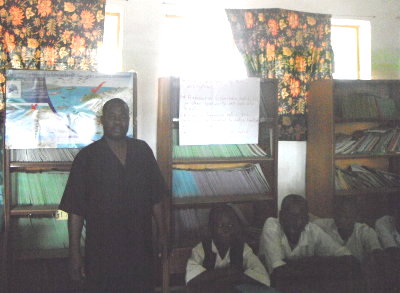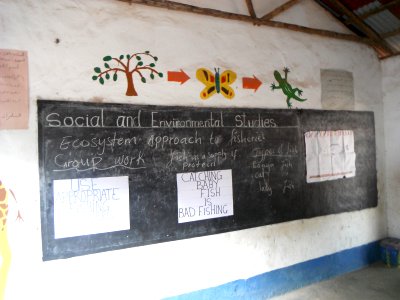During his last monitoring mission in The Gambia, the coordinator has met Mr Jallow, Gambian school inspector in charge of monitoring the pilot activities. Aliou Sall wanted to collect Mr. Jallow's assessment about how the participating schools have carried out the exercises so far, now that the academic year is about to be closed the third week of July. Mr Jallow’s appreciations were recorded through the interview below.
MM-Q: Mr. Jallow, since the starting of the tests of the teaching kit in the context of the FAO - EAF-Nansen Project, meaning since the first seminar 28-29 April 2012, you are closely following the implementation. After the second workshop, held in Serrekunda School for the validation of various tools provided by the project, I come back to The Gambia in order to collect additional feedback concerning the implementing of the pilot phase. I have already exchanged with the teachers of the various schools involved. Now, given your role as an inspector assigned to monitor the process, I would like to have your point of view concerning the significance and achievement of the initiative.

A: The project brought us, generally speaking, an important added value for the syllabus and in particular for the SES subject [SES = social and environmental studies]. In fact, as many of our pupils are coming from fishing communities (if we take into account those from Gunjur and Tanji), we are supposed to be concerned by issues related to marine and coastal resources. Issues related to marine and coastal resources should be targeted in the frame of courses such as SES and science.
In fact, SES has a general core. Based on this first appreciation, we can say that the project is timely. The teachers and thus the pupils consume fish on a daily basis, but were not aware about the issues regarding the marine ecosystem nowadays. This is noteworthy in particular for those coming from Gunjur and Tanji, where fisheries and farming are the base for livelihood. Myself, as a Gambian, I eat fish every day, but I didn’t pay attention to the variety of species and their different names. Something we find too amazing is that, before starting this project, the large majority of teachers and pupils from Gunjur and Tanji had never been at the landing sites for the purpose of measuring fish and for interacting with the Fisheries Department agents and scientists.
MM-Q: In case, you had the opportunity to attend some ongoing exercises in the frame of your various monitoring missions, how did you appreciate the teachers’ commitment?
A: Because, the project is bringing us a concept and tools on issues that are our concerns – as part of fishing communities and/or as consumers - you can understand why teachers, pupils and even the Department of Education is enthusiastic to welcome this project. It was no problem to implement it in The Gambia, because of the existence of the SES, as part of our syllabus.
It is really an important added value for us to apply the SES concept in the marine ecosystem area. I am really impressed by the way the pupils are all committed during exercises in class and by outside observations. If we had the required means, all the pupils would like to participate in the outside observations. But it is already a good start to have some groups in the process. I hope it will be widened to other groups. The groups I saw at certain working sessions are impressing by their dynamism. The Department of Education appreciates the initiative because the Gambian government has given priority to environmental issues in the curriculum.

MM-Q: As the executing agency for FAO - EAF-Nansen Project in this context, Mundus maris is honoured to learn that this project is of interest for the Gambian education programme. But beyond these interesting achievements, may we know what limitations and constraints you identified within the implementation of this phase from your perspective as an inspector in charge of the monitoring on behalf the Education Department, and what are the perspectives for future?
A: The major constraints I noticed and that we have to overcome, if we want to achieve the expected outcomes, are of three types.
First of all, there was limited time available for the tests before the end of the academic year. At the same time, teachers had to make arrangements with their full agenda with the exams that take place between the first and the third week of July. So it was tough for them, but I realize they did a good job, despite time constraints.
Secondly, many exercises were not fully documented because of the lack of audio visual equipments at the right time. I am sure that if all teachers were equipped by digital cameras (at least) the FAO-EAF Nansen Project organisers would appreciate even better the efforts provided between June and July after the initial test phase. I hope that in future and before the next academic year, we will succeed in getting some equipment, at least one digital camera per school and for the inspectors, as far as the activities to be imagined as a longer term process. In fact, the EAF-Nansen principles have to be integrated and practiced for ever in the curriculum.
 The third type of constraints are related to the mobility that is not always evident when it’s time to go to the field for outside observations. We appreciate all kind of support provided by the project in order to enable the holding of the two seminars and the organizing of field trips but it should be important that we obtain a supporting fund in order to start exercises early at the start of the next academic year and have the possibility to have a seminar after one academic year to have an internal evaluation for the use of the Department, because we have the ambition to extend this experience to other schools of The Gambia.
The third type of constraints are related to the mobility that is not always evident when it’s time to go to the field for outside observations. We appreciate all kind of support provided by the project in order to enable the holding of the two seminars and the organizing of field trips but it should be important that we obtain a supporting fund in order to start exercises early at the start of the next academic year and have the possibility to have a seminar after one academic year to have an internal evaluation for the use of the Department, because we have the ambition to extend this experience to other schools of The Gambia.
Finally, there is an important and worrying issue which we need to work on. This concerns the electricity problem. Besides Serrekunda Lower Basic School, none of the schools involved in the project has electricity supplies. Gunjur Lower Basic School had a solar panel that broke down and may be repaired soon.
So, as far as The Gambia alone is concerned, may be the teachers and the pupils will manage with this lack of electricity. But, if the project is intending to develop collaboration and synergy with the Gambian schools and offer better access to additional web-based resources, it will be important to think together how to supply solar panels to schools, even if it’s just for the purpose of good communication by internet between the schools and the project based in Europe at the FAO. In my mind, we have to be make some efforts in this direction. I am convinced we must work out a strategy to equip these schools with solar panels, as least for the running of one computer in each of the participating school. Why not, trying to mobilize funding agencies in Banjul with the help of EAF Nansen-Mundus maris project?
MM: Mr. Jallow, thank you for sharing this assessment with us.








